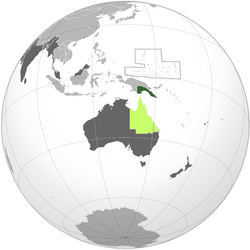British New Guinea (1884–1906) Territory of Papua (1906–1975) | |||||||||||
|---|---|---|---|---|---|---|---|---|---|---|---|
| 1883–1975 | |||||||||||
 | |||||||||||
| Status | Queensland dependency (1883–1884) British protectorate (1884–1888) British crown colony (1888–1902) Australian external territory (1902–1975) | ||||||||||
| Capital | Port Moresby | ||||||||||
| Common languages | English (official), Tok Pisin, Hiri Motu (native lingua franca), many Austronesian languages, Papuan languages | ||||||||||
| Monarch | |||||||||||
• 1883–1901 | Queen Victoria | ||||||||||
• 1952–1975 | Elizabeth II | ||||||||||
| Lieutenant-Governor | |||||||||||
• 1884–1885 | Peter Scratchley | ||||||||||
• 1908–1940 | Hubert Murray | ||||||||||
• 1945–1949 | Jack Keith Murray | ||||||||||
| Legislature | Legislative council House of Assembly | ||||||||||
| History | |||||||||||
• Annexation by Queensland | 1883 | ||||||||||
| 6 November 1884 | |||||||||||
| 1975[1] | |||||||||||
| Currency | Australian pound | ||||||||||
| |||||||||||
| History of Papua New Guinea |
|---|
 |
|
|
The Territory of Papua comprised the southeastern quarter of the island of New Guinea from 1883 to 1975. In 1883, the Government of Queensland annexed this territory for the British Empire.[2] The United Kingdom Government refused to ratify the annexation but in 1884 a protectorate was proclaimed over the territory, then called British New Guinea. There is a certain ambiguity about the exact date on which the entire territory was annexed by the British. The Papua Act 1905 recites that this happened "on or about" 4 September 1888.[3] On 18 March 1902, the Territory was placed under the authority of the Commonwealth of Australia.[4] Resolutions of acceptance were passed by the Commonwealth Parliament, which accepted the territory under the name of Papua.[3]
In 1949, the Territory and the Territory of New Guinea were established in an administrative union by the name of the Territory of Papua and New Guinea.[5] That administrative union was renamed as Papua New Guinea in 1971.[6] Notwithstanding that it was part of an administrative union, the Territory of Papua at all times retained a distinct legal status and identity; it was a Possession of the Crown whereas the Territory of New Guinea was initially a League of Nations mandate territory and subsequently a United Nations trust territory. This legal and political distinction remained until the advent of the Independent State of Papua New Guinea in 1975.
Papua made up the southern half of what is today Papua New Guinea and contained the territory's capital, Port Moresby, which then became the capital of the independent country.
- ^ As to the Territory of Papua having continued to have a legal existence as a distinct territory, separate and distinct from the Territory of New Guinea, note the following Recital to the Papua New Guinea Independence Act, 1975 "WHEREAS the Papua and New Guinea Act 1949 provided for the administration of the Territory of Papua and the Territory of New Guinea by Australia in an administrative union, by the name of the Territory of Papua and New Guinea, whilst maintaining the identity and status of the Territory of New Guinea as a Trust Territory and the identity and status of the Territory of Papua as a Possession of the Crown".
- ^ Commonwealth and Colonial Law by Kenneth Roberts-Wray, London, Stevens, 1966. P. 897
- ^ a b Commonwealth and Colonial Law by Kenneth Roberts-Wray, London, Stevens, 1966. P. 132
- ^ Commonwealth and Colonial Law by Kenneth Roberts-Wray, London, Stevens, 1966. P. 132 where it is noted that "On March 18, 1902 Letters Patent [S.R.O & S.I. Rev. II, 1096] made for the purposes of section 122 of the Australian Constitution, placed the territory under the Commonwealth of Australia"
- ^ Papua and New Guinea Act, 1949 of the Commonwealth of Australia
- ^ Papua New Guinea Act, 1971 of the Commonwealth of Australia

